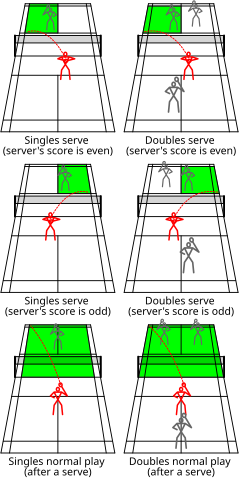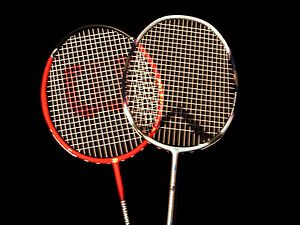The shuttlecock (or shuttle) is a feathered projectile whose unique aerodynamic properties cause it to fly differently from the balls used in most racquet sports; in particular, the feathers create much higher drag, causing the shuttlecock to decelerate more rapidly than a ball. Shuttlecocks have a much higher top speed, when compared to other racquet sports. Because shuttlecock flight is affected by wind, competitive badminton is played indoors. Badminton is also played outdoors as a casual recreational activity, often as a garden or beach game.
Since 1992, badminton has been an Olympic sport with five events: men's and women's singles, men's and women's doubles, and mixed doubles, in which each pair consists of a man and a woman. At high levels of play, the sport demands excellent fitness: players require aerobic stamina, agility, strength, speed and precision. It is also a technical sport, requiring good motor coordination and the development of sophisticated racquet movements.
Court

The court is rectangular and divided into halves by a net. Courts are usually marked for both singles and doubles play, although the laws permit a court to be marked for singles only. The doubles court is wider than the singles court, but both are of same length. The exception, which often causes confusion to newer players, is that the doubles court has a shorter serve-length dimension.
The full width of the court is 6.1 metres (20 ft), and in singles this width is reduced to 5.18 metres (17 ft). The full length of the court is 13.4 metres (44 ft). The service courts are marked by a centre line dividing the width of the court, by a short service line at a distance of 1.98 metres (6 ft 6 inch) from the net, and by the outer side and back boundaries. In doubles, the service court is also marked by a long service line, which is 0.76 metres (2 ft 6 inch) from the back boundary.
The net is 1.55 metres (5 ft 1 inch) high at the edges and 1.524 metres (5 ft) high in the centre. The net posts are placed over the doubles sidelines, even when singles is played.
The minimum height for the ceiling above the court is not mentioned in the Laws of Badminton. Nonetheless, a badminton court will not be suitable if the ceiling is likely to be hit on a high serve.
The Basics

Each game is played to 21 points, with players scoring a point whenever they win a rally regardless of whether they served [7] (this differs from the old system where players could only win a point on their serve and each game was played to 15 points). A match is the best of three games.
At the start of the rally, the server and receiver stand in diagonally opposite service courts (see court dimensions). The server hits the shuttlecock so that it would land in the receiver's service court. This is similar to tennis, except that a badminton serve must be hit below waist height and with the racquet shaft pointing downwards, the shuttlecock is not allowed to bounce and in badminton, the players stand inside their service courts unlike tennis.
When the serving side loses a rally, the serve immediately passes to their opponent(s) (this differs from the old system where sometimes the serve passes to the doubles partner for what is known as a "second serve").
In singles, the server stands in their right service court when their score is even, and in her/his left service court when her/his score is odd.
In doubles, if the serving side wins a rally, the same player continues to serve, but he/she changes service courts so that she/he serves to a different opponent each time. If the opponents win the rally and their new score is even, the player in the right service court serves; if odd, the player in the left service court serves. The players' service courts are determined by their positions at the start of the previous rally, not by where they were standing at the end of the rally. A consequence of this system is that, each time a side regains the service, the server will be the player who did not serve last time
Racquets

Badminton racquets are lightweight, with top quality racquets weighing between 70 and 95 grams (2.4 to 3.3 ounces) not including grip or strings.[8][9] They are composed of many different materials ranging from carbon fibre composite (graphite reinforced plastic) to solid steel, which may be augmented by a variety of materials. Carbon fibre has an excellent strength to weight ratio, is stiff, and gives excellent kinetic energy transfer.
Before the adoption of carbon fibre composite, racquets were made of light metals such as aluminium. Earlier still, racquets were made of wood. Cheap racquets are still often made of metals such as steel, but wooden racquets are no longer manufactured for the ordinary market, because of their excessive mass and cost. Nowadays, nanomaterials such as fullerene and carbon nanotubes are added to rackets giving them greater durability.
There is a wide variety of racquet designs, although the laws limit the racquet size and shape. Different racquets have playing characteristics that appeal to different players. The traditional oval head shape is still available, but an isometric head shape is increasingly common in new racquets.
Shoes
Badminton shoes are lightweight with soles of rubber or similar high-grip, non-marking materials.
Compared to running shoes, badminton shoes have little lateral support. High levels of lateral support are useful for activities where lateral motion is undesirable and unexpected. Badminton, however, requires powerful lateral movements. A highly built-up lateral support will not be able to protect the foot in badminton; instead, it will encourage catastrophic collapse at the point where the shoe's support fails, and the player's ankles are not ready for the sudden loading, which can cause sprains. For this reason, players should choose badminton shoes rather than general trainers or running shoes, because proper badminton shoes will have a very thin sole, lower a person's centre of gravity, and therefore result in fewer injuries. Players should also ensure that they learn safe and proper footwork, with the knee and foot in alignment on all lunges. This is more than just a safety concern: proper footwork is also critical in order to move effectively around the court.
Double
Both pairs will try to gain and maintain the attack, smashing downwards when possible. Whenever possible, a pair will adopt an ideal attacking formation with one player hitting down from the rearcourt, and his partner in the midcourt intercepting all smash returns except the lift. If the rearcourt attacker plays a dropshot, his partner will move into the forecourt to threaten the net reply. If a pair cannot hit downwards, they will use flat strokes in an attempt to gain the attack. If a pair is forced to lift or clear the shuttlecock, then they must defend: they will adopt a side-by-side position in the rear midcourt, to cover the full width of their court against the opponents' smashes. In doubles, players generally smash to the middle ground between two players in order to take advantage of confusion and clashes.
At high levels of play, the backhand serve has become popular to the extent that forehand serves have become fairly rare at a high level of play. The straight low serve is used most frequently, in an attempt to prevent the opponents gaining the attack immediately. Flick serves are used to prevent the opponent from anticipating the low serve and attacking it decisively.
At high levels of play, doubles rallies are extremely fast. Men's doubles is the most aggressive form of badminton, with a high proportion of powerful jump smashes.
Single
The singles court is narrower than the doubles court, but the same length. Since one person needs to cover the entire court, singles tactics are based on forcing the opponent to move as much as possible; this means that singles strokes are normally directed to the corners of the court. Players exploit the length of the court by combining lifts and clears with drop shots and net shots. Smashing is less prominent in singles than in doubles because players are rarely in the ideal position to execute a smash, and smashing often leaves the smasher vulnerable if the smash is returned.
In singles, players will often start the rally with a forehand high serve or with a flick serve. Low serves are also used frequently, either forehand or backhand. Drive serves are rare.
At high levels of play, singles demands extraordinary fitness. Singles is a game of patient positional manoeuvring, unlike the all-out aggression of doubles.
Mixed Doubles
In mixed doubles, both pairs typically try to maintain an attacking formation with the woman at the front and the man at the back. This is because the male players are usually substantially stronger, and can therefore produce smashes that are more powerful. As a result, mixed doubles require greater tactical awareness and subtler positional play. Clever opponents will try to reverse the ideal position, by forcing the woman towards the back or the man towards the front. In order to protect against this danger, mixed players must be careful and systematic in their shot selection.[11]
At high levels of play, the formations will generally be more flexible: the top women players are capable of playing powerfully from the back-court, and will happily do so if required. When the opportunity arises, however, the pair will switch back to the standard mixed attacking position, with the woman in front.
Tidak ada komentar:
Posting Komentar